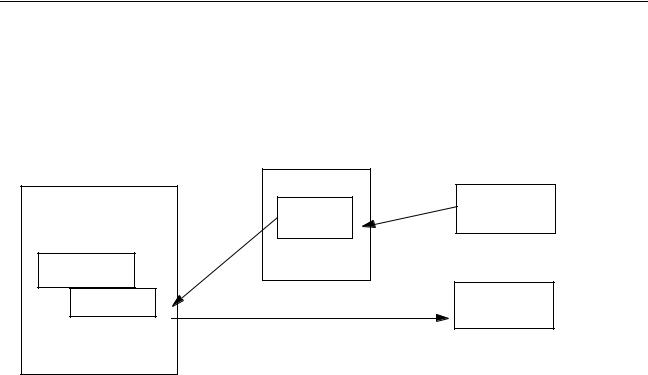
- •Contents
- •Using the Value Change Link (VCL)
- •Overview
- •Purpose
- •Audience
- •Using VCL to Monitor Value Changes
- •Designing a VCL Application
- •The PLI Interface
- •The VCL Interface
- •The VCL Components
- •The Toggle Test Application
- •What Is a Toggle Test?
- •The System Task Syntax
- •The General Structure of the Application
- •VCL Operations
- •Selecting Signals
- •Organizing the Data Structure
- •Starting the Monitor
- •Processing the VCL Data
- •Miscellaneous VCL Tasks

Using the Value Change Link (VCL)
Using the Value Change Link (VCL)
Using VCL to Monitor Value Changes
The VCL is a PLI mechanism you can use to dynamically monitor and extract strength and value change information from Verilog-XL for your application. You can use the VCL in any application that needs to monitor value change data, such as customized monitor facilities, graphics facilities, and analysis tools.
The VCL supports monitoring for the vector and scalar forms of the following data types:
■Register data types (reg, integer, time, real)
■Net data types (wire, tri, wor, wand, trior, triand, tri1, tri0, trireg, supply1, supply0)
■Event data type (event)
The VCL does not support monitoring for the following forms:
■Bit-selects of unexpanded vector nets or registers
■Part-selects
■Memories
■Expressions (such as a+b)
Designing a VCL Application
A VCL application consists of the following components:
■PLI interface
■VCL interface
■VCL routines and data structure
This section describes these components as well as providing suggestions for ways to write more efficient VCL application code.
The PLI Interface
A VCL application is a type of PLI application. Like any other PLI application, a VCL application consists of the C routines that you write to create a new Verilog system task. A
PLI task must contain a calltf routine and, optionally, a checktf routine and a misctf routine. Refer to the following table for descriptions of these routines.
January 2001 |
6 |
Product Version 3.2 |

Using the Value Change Link (VCL)
Using the Value Change Link (VCL)
PLI routines
Routine |
When is it called? |
What is its purpose? |
|
|
|
checktf |
When Verilog-XL encounters the |
Checks the arguments passed to the |
|
PLI task name during |
user-defined PLI task |
|
compilation |
|
calltf |
When Verilog-XL encounters the |
|
PLI task name during simulation |
misctf |
At various times, such as |
|
termination of Verilog-XL |
|
simulation, or when $save or |
|
$restart is executed |
Performs most of the processing for the user-defined PLI task
Performs processing that is necessary when certain system tasks are called or certain events take place—for example, this routine might restore the state of the application when $restart is called
You define your PLI task to Verilog-XL by creating an entry in an array of structures. This array of structures is named veriusertfs, which resides in the file veriuser.c provided in your release directory. The veriusertfs structure is a cross-reference that tells Verilog-XL which of the routines that you write correspond to the checktf, calltf, and misctf routines for the system task.
For further information on the above routines and veriusertfs, refer to the PLI 1.0 User Guide and Reference.
The VCL Interface
A VCL application has the following interface requirements in addition to those of the standard
PLI application:
■Additions to the calltf routine
■A new consumer routine
The calltf routine in a VCL application will typically call the routine acc_vcl_add and pass it a handle to the object to be monitored and a pointer to the consumer routine.
Verilog-XL attaches a trigger to the object. When the object changes value, the trigger is activated, causing Verilog-XL to call the consumer routine. Verilog-XL passes the consumer routine the pointer to a value change record, which contains information about the value change. The consumer routine processes the value change record.
January 2001 |
7 |
Product Version 3.2 |

Using the Value Change Link (VCL)
Using the Value Change Link (VCL)
The following figure shows the interface between a VCL application and Verilog-XL.
The VCL interface
|
PLI |
PLI |
Application |
Verilog-XL |
|
|
|
|
VCL |
|
calltf routine |
|
|
|
|
object |
|
|
|
trigger |
Value change record |
|
consumer |
|
routine |
||
|
|
|
The VCL Components
The Value Change Link facility consists of the following components:
■acc_vcl_add
■acc_vcl_delete
■the value change record
The header file acc_user.h contains the declarations for these components. To access these components, include acc_user.h in your C routines.
acc_vcl_add
You typically call acc_vcl_add in your calltf routine to tell Verilog-XL to start reporting value changes for the specified object to your consumer routine. You can only specify one object per call.
acc_vcl_add takes the following input arguments:
■A handle to the object that the application monitors
January 2001 |
8 |
Product Version 3.2 |

Using the Value Change Link (VCL)
Using the Value Change Link (VCL)
■A pointer to the consumer routine that Verilog-XL calls when that object’s value changes
■A pointer to user-defined data to be passed to the consumer routine when the monitored object changes value
■A flag that specifies whether to monitor logic values, or logic and strength values
acc_vcl_delete
You call acc_vcl_delete within your VCL application to tell Verilog-XL to stop reporting value changes for the specified object. You can only specify one object per call.
acc_vcl_delete takes the following input arguments:
■A handle to the object that the application monitors
■A pointer to the consumer routine that Verilog-XL calls when that object’s value changes
■A pointer to user-defined data to be passed to the consumer routine when the monitored object changes value
■A flag that specifies to stop monitoring value changes
The Value Change Record
The value change record, t_vc_record, is a data structure that is declared in acc_user.h. Verilog-XL uses the value change record to pass logic value and strength changes—and any user data you may have specified in your call to acc_vcl_add—to your consumer routine.
There is only one value change record and it is overwritten every time there is a value change to an object that is being monitored.
Writing Efficient VCL Application Code
The rules you must follow to write efficient code vary somewhat with each VCL application, but the following rules apply to all applications:
■Use the user_data argument to make data access in the consumer routine more efficient.
■Monitor only essential nets.
■Do not use acc_routines in a consumer routine.
In addition, most VCL applications should buffer data. Refer to “Data Buffering” on page 23 for further information.
January 2001 |
9 |
Product Version 3.2 |
